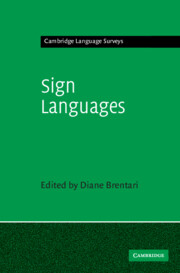Book contents
- Frontmatter
- Contents
- List of figures
- List of tables
- List of contributors
- List of sign language abbreviations
- Notational conventions
- 1 Introduction
- I HISTORY AND TRANSMISSION
- II SHARED CROSSLINGUISTIC CHARACTERISTICS
- III VARIATION AND CHANGE
- 18 Sign languages in West Africa
- 19 Sign languages in the Arab world
- 20 Variation in American Sign Language
- 21 Sociolinguistic variation in British, Australian and New Zealand Sign Languages
- 22 Variation in East Asian sign language structures
- 23 Crosslinguistic variation in prosodic cues
- 24 Deixis in an emerging sign language
- 25 The grammar of space in two new sign languages
- Notes
- References
- Index
22 - Variation in East Asian sign language structures
from III - VARIATION AND CHANGE
Published online by Cambridge University Press: 05 June 2012
- Frontmatter
- Contents
- List of figures
- List of tables
- List of contributors
- List of sign language abbreviations
- Notational conventions
- 1 Introduction
- I HISTORY AND TRANSMISSION
- II SHARED CROSSLINGUISTIC CHARACTERISTICS
- III VARIATION AND CHANGE
- 18 Sign languages in West Africa
- 19 Sign languages in the Arab world
- 20 Variation in American Sign Language
- 21 Sociolinguistic variation in British, Australian and New Zealand Sign Languages
- 22 Variation in East Asian sign language structures
- 23 Crosslinguistic variation in prosodic cues
- 24 Deixis in an emerging sign language
- 25 The grammar of space in two new sign languages
- Notes
- References
- Index
Summary
Introduction
In this chapter, we shall discuss the history, transmission, and grammars of the two major sign language families in East Asia: the Chinese Sign Language family and the Japanese Sign Language family. We shall not be covering the rest of Asia; for South Asian sign languages, see Zeshan (2000). Neither will we be discussing Southeast Asian sign languages (e.g., the Indochinese peninsula, Malaysia, Indonesia, or the Philippines). Relatively little has been published on the grammars of these languages, and we have neither the space nor the expertise to comment on them. In our discussions of East Asian sign languages, we shall concentrate on those aspects that differ from what is found in Western sign languages.
The Chinese Sign Language family includes the northern and southern dialects of Chinese Sign Language (CSL) and Hong Kong Sign Language (HKSL), historically a variety of the southern CSL dialect. The Japanese family includes Japanese Sign Language (JSL), Taiwan Sign Language (TSL) and Korean Sign Language (KSL). Unless otherwise indicated, what we are reporting here is based on our own ongoing or published research on CSL, JSL and TSL.
The two families and their histories
Chinese Sign Language family
It is difficult to discuss the history of a national sign language without also talking about the history of deaf education; China and Japan are no exceptions.
- Type
- Chapter
- Information
- Sign Languages , pp. 499 - 518Publisher: Cambridge University PressPrint publication year: 2010
- 21
- Cited by



